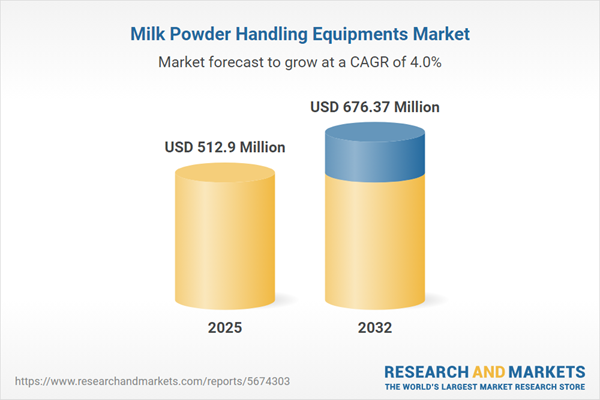Speak directly to the analyst to clarify any post sales queries you may have.
The Milk Powder Handling Equipments Market is evolving rapidly, driven by the increasing complexity of food manufacturing and stringent requirements for efficiency, compliance, and sustainability. Robust solutions are in demand as milk powder processors adapt operations to stay ahead of regulatory and market shifts.
Market Snapshot: Accelerating Growth in Milk Powder Handling Equipments
The global Milk Powder Handling Equipments Market grew from USD 493.39 million in 2024 to USD 512.90 million in 2025. The market is projected to expand at a CAGR of 4.02%, reaching USD 676.37 million by 2032.
This sustained growth reflects rising investment in advanced handling solutions, upgrade cycles for legacy plants, and a worldwide emphasis on food safety, traceability, and energy efficiency.Scope & Segmentation: In-depth Analysis for Strategic Market Entry
- Equipment Types: Conveying Systems, Filling Machines, Mixing Equipment, Packaging Machines, Palletizers, Sieving Equipment, Storage Silos
- Conveying Systems: Belt Conveyors, Pneumatic Conveyors, Screw Conveyors
- Filling Machines: Auger Fillers, Net Weigh Fillers, Piston Fillers
- Mixing Equipment: Paddle Mixers, Ribbon Blenders, V-Blenders
- Packaging Machines: Form Fill Seal, Retort Packaging, Vacuum Packaging
- Palletizers: Conventional Palletizers, Robotic Palletizers
- Sieving Equipment: Centrifugal Sieve, Vibrating Sieve
- Storage Silos: Horizontal Silos, Vertical Silos
- End-user Industries: Bakery (Bread, Cakes), Confectionery (Candy, Chocolate), Dairy Processing (Butter, Cheese, Yogurt), Infant Formula (Stages 1, 2, 3), Nutraceutical (Protein, Vitamin Powders), Pharmaceutical (Capsules, Tablets)
- Automation Level: Fully Automated, Manual, Semi Automated
- Capacity: Large, Medium, Small Capacity Units
- Distribution Channels: Direct Sales, Distributor Sales, Online Sales
- Regional Coverage: Americas (United States, Canada, Mexico, Brazil, Argentina, Chile, Colombia, Peru), Europe, Middle East and Africa (United Kingdom, Germany, France, Russia, Italy, Spain, Netherlands, Sweden, Poland, Switzerland, United Arab Emirates, Saudi Arabia, Qatar, Turkey, Israel, South Africa, Nigeria, Egypt, Kenya), Asia-Pacific (China, India, Japan, Australia, South Korea, Indonesia, Thailand, Malaysia, Singapore, Taiwan)
- Leading Companies Analyzed: GEA Group Aktiengesellschaft, SPX FLOW, Inc., Tetra Pak International S.A., Bühler AG, Glatt GmbH, Bucher Industries AG, Allgaier Process Technology GmbH, Hosokawa Micron B.V., Alfa Laval AB, IMA Dairy & Food S.p.A.
Key Takeaways for Senior Decision-makers
- Digital transformation is reshaping equipment management, as manufacturers adopt advanced sensors, predictive diagnostics, and real-time controls to minimize downtime and drive consistent product quality.
- Hygiene and safety requirements dominate equipment selection, especially for sectors such as infant formula and pharmaceuticals, which demand sterilizable solutions and precise movement of sensitive powders.
- Energy-efficient drive systems and closed-loop cleaning processes are gaining favor to help manufacturers achieve sustainability objectives and reduce operational costs over the equipment lifecycle.
- Adoption of modular and scalable solutions allows businesses to future-proof investments and rapidly adapt lines for emerging product trends or changing regulatory standards.
- Supply chain agility is increasingly critical; companies are diversifying sourcing, seeking regional alternatives, and prioritizing local subassembly manufacturing to counter disruptions and maintain continuity.
Tariff Impact: Navigating New US Trade Policies
Recent United States tariffs on imported dairy processing machinery have altered sourcing strategies across the milk powder handling equipment sector. Heightened duties on equipment and replacement parts have spurred demand for domestic manufacturing but also introduced lead-time and capacity challenges. Some processors are re-evaluating maintenance regimes, inventory strategies, and supplier collaborations to offset tariff-driven costs. These developments highlight the importance of adaptable procurement frameworks and comprehensive total cost analyses for ongoing risk mitigation and competitiveness.
Methodology & Data Sources
This report relies on a combination of primary interviews with manufacturers, facility managers, and consultants, as well as secondary sources from regulatory filings, technical publications, white papers, and trade data. Triangulation with real-world case studies, financial disclosures, and expert reviews ensures validity and actionable insight.
Why This Report Matters for Your Strategic Planning
- Uncovers actionable segmentation and regional dynamics critical for equipment selection, capital allocation, and operational network design.
- Delivers visibility into competitive strategies, R&D priorities, and partnership approaches adopted by global leaders in milk powder handling equipment.
- Equips decision-makers with scenario-based recommendations to strengthen supply chain resilience and guide sustainable investment decisions.
Conclusion
The Milk Powder Handling Equipments Market continues to evolve in response to regulatory change, technology integration, and new consumer needs. Informed choices in equipment design, procurement, and maintenance will position your business for long-term operational resilience and growth.
Additional Product Information:
- Purchase of this report includes 1 year online access with quarterly updates.
- This report can be updated on request. Please contact our Customer Experience team using the Ask a Question widget on our website.
Table of Contents
3. Executive Summary
4. Market Overview
7. Cumulative Impact of Artificial Intelligence 2025
Companies Mentioned
The companies profiled in this Milk Powder Handling Equipments market report include:- GEA Group Aktiengesellschaft
- SPX FLOW, Inc.
- Tetra Pak International S.A.
- Bühler AG
- Glatt GmbH
- Bucher Industries AG
- Allgaier Process Technology GmbH
- Hosokawa Micron B.V.
- Alfa Laval AB
- IMA Dairy & Food S.p.A.
Table Information
| Report Attribute | Details |
|---|---|
| No. of Pages | 196 |
| Published | October 2025 |
| Forecast Period | 2025 - 2032 |
| Estimated Market Value ( USD | $ 512.9 Million |
| Forecasted Market Value ( USD | $ 676.37 Million |
| Compound Annual Growth Rate | 4.0% |
| Regions Covered | Global |
| No. of Companies Mentioned | 11 |









